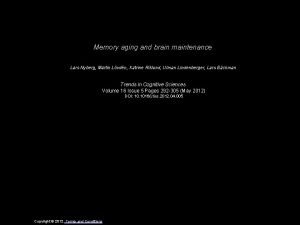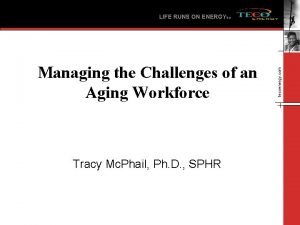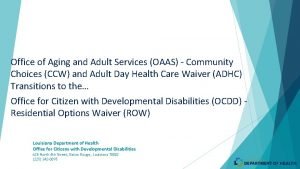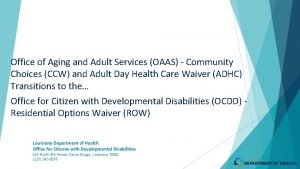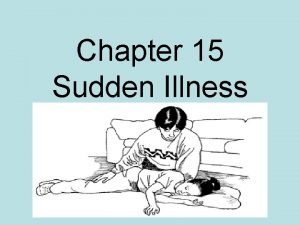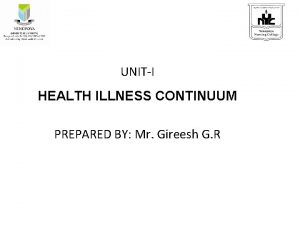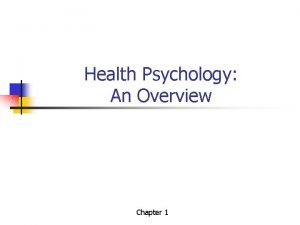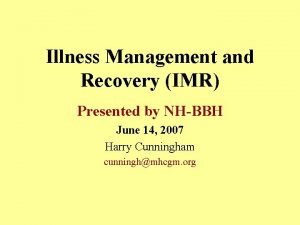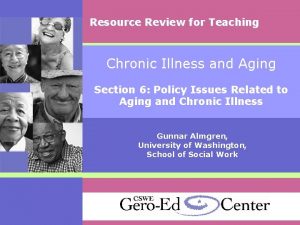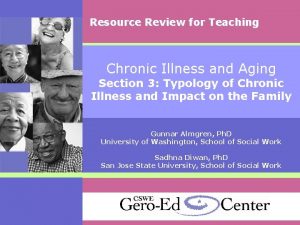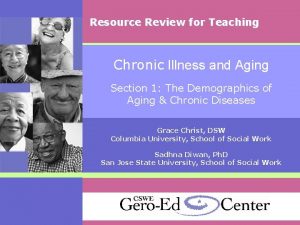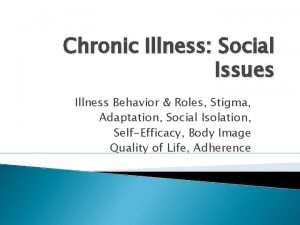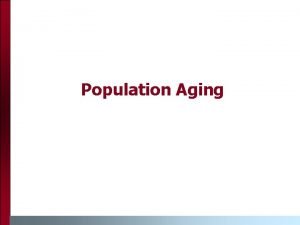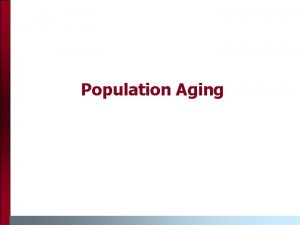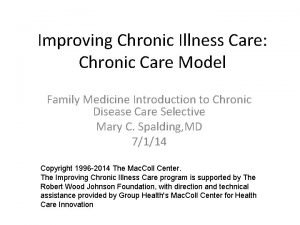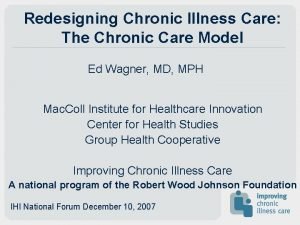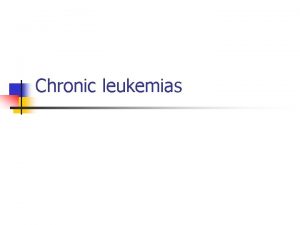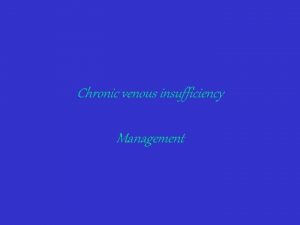Resource Review for Teaching Chronic Illness and Aging
































- Slides: 32

Resource Review for Teaching Chronic Illness and Aging Section 2: The Role of Social Work in Managing Chronic Illness Care Grace Christ, DSW Columbia University, School of Social Work Sadhna Diwan, Ph. D San Jose State University, School of Social Work

Role of Social Work in Managing Chronic Illness Care Synopsis This section describes some of the most recent literature addressing the role of social workers in managing chronic illness care specifically related to conducting biopsychosocial assessments, providing interventions, and in designing and implementing effective models of health services delivery such as care coordination.

Changing Characteristics of Chronic Illnesses § Three important characteristics of chronic illnesses among older adults need to be considered as they affect the social work role and function. • Trajectory for many serious illnesses has changed from acute to chronic period, with episodes of exacerbations and remissions interspersed with extended periods of good functioning. • Trajectory of advanced chronic and terminal illnesses has changed from a relatively brief period to a longer period in which both curative and palliative treatments are combined. • There is an increase in the total numbers of older people with advanced chronic and terminal illnesses who will require more curative and palliative care being provided in the home with greater reliance on provision by family members.

Role Of Social Work In Addressing Chronic Illnesses § Assessing biopsychosocial health-related needs of patient and family. § Providing interventions required to address these biopsychosocial needs and promote their adaptation to illness and disability. § Developing and implementing effective models of health services delivery.

Psychosocial Assessment of Older Adults with Chronic Conditions § Synopsis This section reviews the evidence supporting comprehensive geriatric assessments and, using a biopsychosocial framework describes the rationale or evidence supporting seven typical domains of psychosocial assessment for social workers in the management of chronic illnesses.

Comprehensive Assessments § Comprehensive geriatric assessment (CGA) and geriatric evaluation and management (GEMs) programs have had positive impact on improving or maintaining cognitive and physical function (Urdangarin, 2000). § The primary component of CGA and GEM programs is an interdisciplinary team consisting primarily of physicians, nurses, and social workers. § CGA is more effective when it is targeted to older adults with functional impairments, geriatric syndromes. , or high use of hospital and nursing home care.

Comprehensive Assessments § Comprehensive assessment is not feasible for all elders; therefore, programs have developed criteria to target individuals most likely to need such assessments. These criteria include: § Functional impairments in their ability to perform activities of daily living; § Have one or more geriatric syndromes, such as falls, depression, dementia, delirium, or weight loss; or § Show patterns of high use of hospital or nursing home placements § With increasing numbers of elders with chronic illness living in the community, screening and assessment becomes increasingly important to the provision of continuity of care to identify those with biopsychosocial needs.

Process of Conducting Geriatric Assessments § Involves using general social work clinical interviewing skills as well as knowledge of special conditions that may apply to working with specific populations. § Relevant Skills and Processes: § Establishing rapport with the respondent. § Explaining the purpose of assessment. § Using observation and clinical judgment. § Assessing the client’s preferences. § Knowledge of human behavior and caregiver dynamics. § Cultural competency in addressing and understanding diverse groups of older persons. Source: Geron (2006) and Berkman and colleagues (2002)

Biopsychosocial Framework for Seven Domains of Assessment § To develop a substantive understanding of an older adult’s needs and resources there are seven typical domains of assessment that are important for social workers. 1. Physical well-being and health 2. Psychological well-being and mental health 3. Cognitive capacity 4. Ability to perform basic activities of daily living (ADLs) and instrumental activities of daily living (IADLs) 5. Social Functioning 6. Physical environment 7. Assessment of family caregivers

Major Domains of Assessment Evidence or Rationale Supporting Specific Areas of Assessment within Each Domain § Prevalence of chronic diseases increases significantly Physical well-being and health with age. Most common health problems are arthritis, cardiovascular disease, cancer, and diabetes. § These health conditions are influenced by both familial predispositions and behavioral risk factors. § Important areas of assessment are overall health status; the presence of pain; nutritional status; risk for falling; incontinence; sleep; alcohol and drug use; dental or oral health; and sensory perception, especially vision and hearing and use and misuse of medications. § These conditions influence other domains, such as lowering psychological well-being, limiting functional ability, and diminishing quality of life. Source: adapted from Diwan & Balaswamy, (2006)

Major Domains of Assessment Psychological well-being and mental health. Evidence or Rationale Supporting Specific Areas of Assessment within Each Domain § Depression, anxiety, and dementia are frequently under diagnosed, partly because symptoms can be misattributed to health problems, and because of stereotypical beliefs that aging is associated with increased negative affect. § Substance use, misuse, or abuse, particularly of alcohol, prescription drugs, and over-the-counter medications, is also under diagnosed, often because decreased activity among the elderly is attributed to other age-related factors. § As an indicator of problems with mental health and psychological well-being, the rate of completed suicide in the U. S. is the highest among people over 65 years of age. Source: adapted from Diwan & Balaswamy, (2006)

Major Domains of Assessment Cognitive capacity Evidence or Rationale Supporting Specific Areas of Assessment within Each Domain § Two distinct types of cognitive changes occur as people age. The first is normal, gradual decline in memory, selective attention, information processing, and problem-solving ability. § The second is a progressive, irreversible, global deterioration in capacity that occurs as a result of illnesses or diseases such as Alzheimer’s, Huntington’s, Parkinson’s, and AIDS; vascular dementia often caused by strokes or tumors. § As the dementia progresses, significant changes occur in memory, language, object recognition, and executive functioning: the ability to plan, organize, sequence, and abstract. § Behavioral symptoms, such as agitation, hallucinations, and wandering also are common. These behaviors need increased supervision, which often causes considerable strain and burden on caregivers, both formal and informal. § Source: adapted from Diwan & Balaswamy, (2006)

Major Domains of Assessment Evidence or Rationale Supporting Specific Areas of Assessment within Each Domain § Functional ability is measured through performance in: Ability to perform various • Activities of daily living (ADLs), which include dressing, bathing, eating, grooming, toileting, transferring from bed activities of or chair, mobility, and continence; daily living • Instrumental activities of daily living (IADLs), which include cooking, cleaning, shopping, money management, use of transportation, telephone, and administration of medications. § Increasing disability in doing these activities predicts a person’s movement along the continuum of care, ranging from independent living to assisted living to nursing home care § A variety of physical, psychological, cognitive, and environmental factors influence a person’s ability to perform ADLs and IADLs. Evaluation of all factors that may contribute to a person’s disability is recommended. § Source: adapted from Diwan & Balaswamy, (2006)

Major Domains of Assessment Social functioning Evidence or Rationale Supporting Specific Areas of Assessment within Each Domain § Social integration (having social ties, roles, and activities) is associated with better health outcomes, such as lower risk of mortality, cardiovascular disease, cancer mortality, and functional decline. § Health also affects social functioning because people who are confined to bed or have severely impaired mobility are likely to disengage from social activities. § Satisfaction with one’s social support is more strongly related to psychological well-being than are objective indicators of social functioning, such as frequency of social contact § Source: adapted from Diwan & Balaswamy, (2006)

Major Domains of Assessment Physical environment Evidence or Rationale Supporting Specific Areas of Assessment within Each Domain § The risk of falls increases with age; falls are the leading cause of deaths and are the most common cause of injuries and hospital admissions for trauma. For elders, two-thirds to onehalf of falls occur in or around the home. § Assessing the fit between the older person’s capabilities and his or her home environment is a critical intervention for the prevention of falls. § Typical home assessments examine the condition, adequacy, and accessibility of lighting, flooring, carpeting, including obstacles or potential hazards for falling; bathing and toileting, including the need for assistive devices; kitchen; heating and cooling; access to the home from outside; access to rooms within the home; and personal safety issues, such as neighborhood conditions. § Elders may prefer to live in an environment that a professional regards as inadequate but that permits them more freedom and social connection. “Negotiated risk, ” where older persons have a voice in determining their level of risk-taking, may be one way to integrate this idea into the assessment process. Source: adapted from Diwan & Balaswamy, (2006)

Evidence or Rationale Supporting Specific Areas of Assessment within Each Domain Major Domains of Assessment § Approximately 66% of community-dwelling people who need long-term care rely solely on family and friends for of family help, and 28% receive a combination of informal and caregivers formal care. § The need for increased vigilance strains caregivers considerably, which in turn puts the elder person at greater risk for entering a nursing home and increases the likelihood of abuse or neglect. § Important to assess both objective and subjective components of caregivers’ strain to gain a better understanding of their needs. § Objective components of burden refer to the disruption in finances, family life, and social relations, whereas subjective components refer to caregivers’ appraisal of their situation as stressful. Source: adapted from Diwan & Balaswamy, (2006)

Biopsychosocial Needs & Services for Chronic Illness Care § Aging populations require diverse biopsychosocial services from both formal and informal sources. § The evidence supporting the effectiveness of various biopsychosocial services is mixed (IOM, 2007). § There is generally good evidence (through meta analyses of randomized controlled trials) of the effectiveness of psychotherapeutic services, especially cognitive behavioral therapy, that help ameliorate emotional distress that cooccurs with many chronic illnesses. § Similar level of evidence exists for behavioral interventions that help individuals manage their symptoms and improve their overall health. § However, many interventions such as the provision of transportation, financial assistance, and medication assistance have not been examined specifically for effectiveness but are widely accepted as humanitarian services necessary to address basic needs.

Biopsychosocial Health Needs Social Work Interventions: Evidence-Informed Services to Address Needs Information about illness, treatments, health, and services Help in coping with emotions, illness and treatment § Provision of information, e. g. , on illness, treatments, effects on health, psychosocial services, and helping patients/families understand use information. § Peer support programs. § Counseling/psychotherapy to individuals or groups. § Pharmacological management of psychological symptoms. Help in managing illness § Comprehensive disease management/self-care programs. § Coordinated care programs that organize patient care to facilitate more appropriate delivery. § Behavioral/health promotion interventions such as: Provider assessment/monitoring of health behaviors such as diet, smoking, exercise; Brief physician counseling; Patient education on risk reduction. Assistance changing behaviors to minimize impact of disease § Provision of resources such as transportation, home care, improvement of home environment. Help in managing § Family/caregiver education, counseling. disruptions in work, § Assistance with activities of daily living (ADLs & IADLs), activities, family life, and § Legal protections and services. social network § Social network development. Material and logistical resources Financial advice and/or § Financial planning/counseling including activities such as bill paying. assistance § Insurance counseling/advocacy. § Eligibility assessment for other benefits (SSI and SSDI. § Supplemental financial grants. ( Source: !OM, 2008)

Care Coordination as a Model of Health Services Delivery: The Evidence Base What is care coordination? § Care coordination is the deliberate organization of patient care activities between two or more participants (including the patient) involved in a patient’s care to facilitate the appropriate delivery of health care services (Mc. Donald et al. , 2007).

Care Coordination as a Model of Health Services Delivery: The Evidence Base The Need for Care Coordination § The structure of the health care delivery system in the U. S. is marked by fragmentation, complexity, pervasive deficiencies and remarkable variation in patient safety and healthcare quality. § Older patients are more vulnerable to suffer the negative consequences of this fragmentation as they often have complex management regimens for their chronic conditions, strained or reduced family support, and lower health literacy. § The range of psychosocial services described earlier that are useful in improving the health and quality of life of elders are located in various delivery systems in the community making it difficult for elders and families to access these services.

Models of Care Coordination Programs § The need for care coordination is critical at several points in the health care delivery system and several models of care coordination programs have been developed to address specific needs. § Some of the major models of care coordination are outlined with an example of an evidence-supported care coordination program and its specific outcomes. Many of these models of care coordination include social workers in the intervention.

Models of Care Coordination and Examples 1. INTERDISCIPLINARY TEAM CARE Providers from different disciplines collaboratively manage the care of a patient. Example: Program for All-Inclusive Care for the Elderly (PACE) Specific Aim: Within a managed-care program (for those eligible for Medicaid and Medicare), address the spectrum of needs for adults aged 55 and older whose disability level qualifies them for nursing-home care. Source: Institute of Medicine, 2008.

Models of Care Coordination and Examples 2. CARE MANAGEMENT In most forms a nurse or social worker provides patients (and sometimes families) a combination of health assessment, planning, education, behavioral counseling, and coordination. Their communication with primary care providers varies from frequent to rare, depending on the care -management program. Example: Improving Mood: Promoting Access to Collaborative Treatment for Late Life Depression (IMPACT) Specific Aim: To treat depression in primary care settings as depression is common among individuals with chronic illness. Source: Institute of Medicine, 2008.

Models of Care Coordination and Examples 3. CHRONIC DISEASE SELF-MANAGEMENT PROGRAMS Self management programs are structured, time-limited interventions designed to provide health information and to empower patients to assume an active role in managing their chronic conditions. Some are led by health professionals and focus on the management of specific conditions, such as stroke, while others are led by trained laypersons and address chronic conditions more generally. Example: Chronic Disease Self-Management Program (CDSMP) Specific Aim: To teach self-management skills useful for managing a variety of chronic diseases such as arthritis, diabetes, lung and heart disease. Source: CDC.

Models of Care Coordination and Examples 4. PREVENTIVE HOME VISITS Home visits are provided to older persons by nurses or other visitors to monitor health and functional status and to encourage self-care and appropriate use of health care services. These visitors usually visit their clients quarterly and communicate regularly with their patients’ primary care providers. Example: Geriatric Resources for Assessment and Care of Elders (GRACE) Specific Aim: Providing health care for low-income older adults as they face several challenges including high incidence of chronic illness, limited access to care, low health literacy, and socioeconomic stressors which lead to unmet need and greater burden of illness. Source: Institute of Medicine, 2008.

Models of Care Coordination and Examples 5. CAREGIVER EDUCATION AND SUPPORT These community-based programs are designed to help the informal caregivers of older persons with chronic conditions such as dementia and stroke. Led by psychologists, social workers, or rehabilitation therapists, these programs provide varying combinations of health information, training, access to professional and community resources, emotional support, counseling, and coping strategies. Example: Resources for Enhancing Alzheimer's Caregiver Health II (REACH II) Specific Aim: Support caregivers of persons with dementia. Source: National Registry of Evidence-Based Programs and Practices, SAMHSA.

Models of Care Coordination and Examples 6. TRANSITIONAL CARE Typically a nurse or an advance-practice nurse prepares and coaches the patient and informal caregiver for the transition from hospital discharge to home care. Example: The Care Transitions Program Specific Aim: To help patients with complex care needs learn self-management skills to ensure their needs are met during the transition from hospital to home. Source: The Care Transitions Program. www. Care. Transitions. org

Features of Innovative Care Coordination Models § The committee concluded that no single one of the models described above would be sufficient to meet the needs of all older adults. § After reviewing the evidence on a number of different models of care, the IOM committee concluded that some of the models with the strongest evidence of success in improving care quality, health-related outcomes, or efficiency have common features which may contribute to their success.

Common Components of Care Coordination Programs Include: 1. Essential care tasks (e. g. , assess client and develop a care plan) 2. Associated coordination activities (e. g. , service arranging, psycho-education) 3. Common features of interventions to support coordination activities (e. g. , standardized protocols and manuals, multidisciplinary teams)

Relationship between care coordination interventions and the social work profession’s knowledge, skill, and value base 1. Patient education 2. Self management 3. Provider education 4. Provider reminders to patients (e. g. , regarding appointments, procedures). 5. Audit and feedback 6. Relay of clinical data 7. Organizational change (e. g. , adding staff, changing or adding programs). 8. Financial and regulatory incentives (e. g. , compensated time for patient education).

Evidence for Care Coordination Programs § Although the evidence for the effectiveness of care coordination programs is significant. § It is currently not adequate to determine the relative effectiveness of any particular strategy compared to other strategies in improving patient outcomes. § Few intervention studies have clearly identified their component parts, the specific aspects of these interventions that are most effective also are unknown.

Overall Benefits Of Care Coordination § Care coordination strategies for older adults have shown reduced numbers of hospital admissions. § Interventions by multidisciplinary teams have shown improved continuity of service for severely mentally ill patients, reduced mortality and hospital admissions for heart failure patients, reduced symptoms for terminally ill patients, and reduced mortality and dependency for stroke patients. § Disease management programs have shown reduced severity of depression and improved adherence to treatment in patients with mental illness, reduced mortality and hospital admissions in patients with heart failure, and improved glycemic control in patients with diabetes. § Case management programs have shown reduced rates of rehospitalization among patients with mental health problems, and improved glycemic control among patients with diabetes. Source: AHRQ (2007)
 Improving chronic illness care model
Improving chronic illness care model Uky disability resource center
Uky disability resource center Dane county aging and disability resource center
Dane county aging and disability resource center Resource leveling is the approach to even out the peaks of
Resource leveling is the approach to even out the peaks of Contoh resource loading
Contoh resource loading Phases of micro teaching
Phases of micro teaching Chicken market forms
Chicken market forms Jessie emily schofield poem
Jessie emily schofield poem Memory aging and brain maintenance
Memory aging and brain maintenance Managing the aging workforce challenges and solutions
Managing the aging workforce challenges and solutions Office of aging
Office of aging Office of aging and adults services
Office of aging and adults services Chapter 20 mental health and mental illness
Chapter 20 mental health and mental illness What are sudden illnesses
What are sudden illnesses Health illness continuum model
Health illness continuum model Illness and wellness continuum
Illness and wellness continuum Illness and wellness continuum
Illness and wellness continuum Nhbbh
Nhbbh Formuö
Formuö Typiska drag för en novell
Typiska drag för en novell Tack för att ni lyssnade bild
Tack för att ni lyssnade bild Vad står k.r.å.k.a.n för
Vad står k.r.å.k.a.n för Shingelfrisyren
Shingelfrisyren En lathund för arbete med kontinuitetshantering
En lathund för arbete med kontinuitetshantering Särskild löneskatt för pensionskostnader
Särskild löneskatt för pensionskostnader Personlig tidbok för yrkesförare
Personlig tidbok för yrkesförare Anatomi organ reproduksi
Anatomi organ reproduksi Densitet vatten
Densitet vatten Datorkunskap för nybörjare
Datorkunskap för nybörjare Tack för att ni lyssnade bild
Tack för att ni lyssnade bild Att skriva debattartikel
Att skriva debattartikel Magnetsjukhus
Magnetsjukhus Nyckelkompetenser för livslångt lärande
Nyckelkompetenser för livslångt lärande








